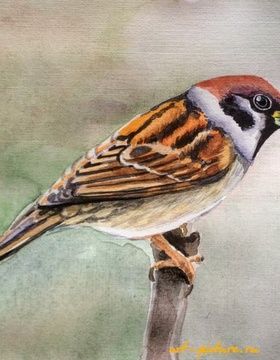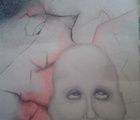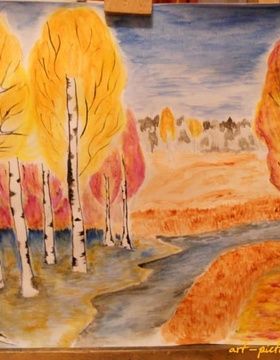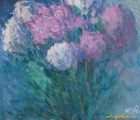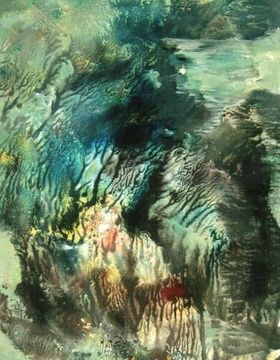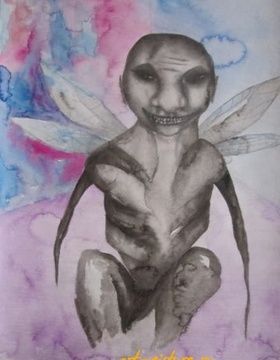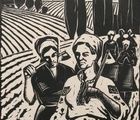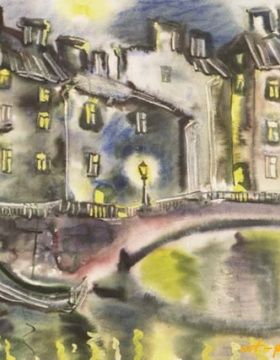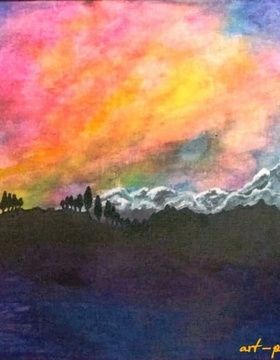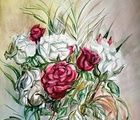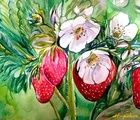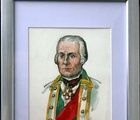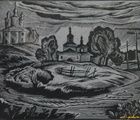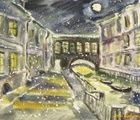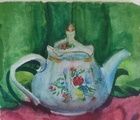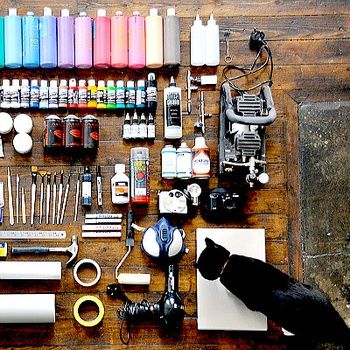
Графика и её виды
Искусство - одно из важнейших и интереснейших явлений в жизни общества, неотъемлемая часть человеческой деятельности, играющая значительную роль в развитии не только отдельной личности, но и общества. Суть искусства определяется тем, что что оно представляет собой наиболее полную и действенную форму эстетического осознания окружающего мира. Само собой, искусство должно было принять разнообразные формы чтобы воплотить все идеи, мысли, чувства людей не в виде отвлеченных понятий, а во вполне конкретной форме. Для этого у искусства есть особое, только ему присущее средство - художественный образ. С помощью художественных образов искусство передает идеи в единстве содержания и чувственных форм. Однако, художественный образ предстает совершенно различным в разных видах искусства. Каждый вид искусства обладает своей спицификой, ставит собственные задачи и создает для их решения свои средства и приемы. Все искусства имеют свой собственный язык и определенное своеобразие художественных возможностей. В данной работе я постараюсь как можно точнее отразить особенности создания художественного образа в искусстве графики.
Во-первых, графика относится к пространственным (пластическим) искусствам, то есть графическое художественное произведение имеет конкретный материальный носитель и не нуждается во временной компоненте как временные искусства, которые развиваются во времени (музыка, художественное слово).
Во-вторых, графика относится к изобразительным искусствам, то есть она отражает действительность в наглядных, зрительно воспринимаемых образах, в которых узнаются формы самой действительности и благодаря методом обобщения, типизации, воображению художника получает возможность эстетически раскрывать временное развитие событий, духовный облик, переживания, мысли,взаимоотношения людей, воплощать общественные идеи (в отличии от архитектуры, которая не изображает окружающий мир, а создает мир собственный, не похожий на действительность, данную нам природой).
Графика может быть подразделена на три вида:
монументальную - тесно связанную с архитектурным ансамблем, например, плакат (монументальная печатная графика), настенная графика, картоны;
станковую - выполняемую “на станке”, не имеющую связи с определенным интерьером, назначение и смысл произведения полностью исчерпывается художественным содержанием (рисунок, эстамп, лубок);
декоративную - книжные иллюстрации, открытки, любые графические изображения на любом предмете, не имеющие особенной художественной ценности, а служащие для организации поверхности предмета. Также к декоративной графике относится флористика - композиции, созданные при помощи пуха деревьев, соломок и других “живых” материалов.
Специфику искусства графики составляет рисунок.
Рисунок (как художественно-выразительное средство) хоть и используется во всех видах изобразительного искусства, но в графике он является ведущим, определяющим началом и применяется в более чистом виде. Поэтому можно считать рисунок главным средством графики (как пластику - в скульптуре, цвет - в живописи).
Само слово “графика” ведет свое начало от греческого grapho - пишу, рисую. Рисунок демонстрирует характер, темперамент, настроение художника. Язык графики основан, главным образом, на выразительных возможностях линии, штриха, пятна (иногда цветового), фона основы (обычно листа бумаги - белой или тонированной) с которым изображение образует контрастное или нюансное соотношение. Не смотря на то, что цвет в графике имеет большое значение, но используется все же более ограниченно, чем в живописи. Графика тяготеет к монохромности, чаще всего извлекая художественную выразительнось из сочетания двух цветов: белого (либо другого оттенка основы) и черного (или какого-либо другого цвета красящего пигмента).
Станковая графика : эстамп и рисунок
Эстамп - от французского estamper - штамповать, оттискивать - оттиск на бумаге. Первоначальное изображение делается не непосредственно на бумаге, а на пластине какого-либо твердого материала, с которой потом рисунок печатается, оттискивается с помощью пресса. При этом можно получить не один экземпляр оттиска, а много, то есть тиражировать графическое изображение. Печатание применяется и в прикладной графике, в плакате, книжной иллюстрации. Но там печатная форма изготавливается с оригинала, выполненного художником, фотомеханическим, машинным путем. В станковой же графике для эстампа печатная форма создается самим художником, поэтому получается ряд экземпляров подлинных произведений искусства одинаковой художественной ценности, полностью сохраняющих живой и непостредственный отпечаток творческой работы автора.
Сам процесс создания печатной формы из какого-либо твердого материала - дерева, металла, линолеума - называется гравированием (от французского слова graver - вырезать). Рисунок создается с помощью вырезания, процарапывания каким-либо острым инструментом - иглой, резцом. Произведения графики, отпечатанные с гравировальной печатной формы, называют гравюрой.
плоская гравюра - рисунок и фон находятся на одном уровне;
выпуклая гравюра - краска покрывает поверхность рисунка - рисунок выше уровня фона;
углубленная гравюра - краска заполняет углубления, рисунок ниже уровня фона.
Литография- печатной формой является поверхность камня (известняка). Камень очень гладко полируется и обезжиривается. Изображение на литографический камень наносится специальной жирной литографической тушью или карандашом. Камень смачивается водой, далее накатывается краска, пристающая только к ранее нанесенному рисунку. Литография изобретена в 1798 году. В 19 веке получает распространение в станковой и социально-критической журнальной графике. (Французский художник Оноре Домье: “Опустите занавес, фарс сыгран” 1834г., “Улица Транснонен, 15 апреля 1834 года” 1834г., с 1837 по 1851г. - приблизительно 30 литографических серий - “Робер Манер”, “Парижские типы”, “Добропорядочный буржуа”, “Деятели правосудия”.)
Альграфия - плоская печать, техника исполнения аналогична литографии, но вместо камня используется аллюминиевая пластина.
Ксилография - гравюра на дереве, вырезается специальным резцом. Краска накатывается на плоскость исходной доски. При печати на бумаге белыми остаются участки, вырезанные резцом. Оттиски представляют собой контурный рисунок толстыми черными линиями. Ксилография появилась в средние века всвязи с необходимостью книгопечатания. (Германские художники Альбрехт Дюрер: “Четыре всадника” 1498г. и Ганс Гольбейн Младший серия гравюр “Образы смерти” 1524-1525г.г. )
Линогравюра - гравюра на линолеуме. По технике очень близка к ксилографии. Линолеум - недорогой, доступный материал. Линогравюры более просты в исполнении по сравнению с ксилографией из-за синтетического происхождения используемого материала (однородность, овтсутствие мешающих резцу искусственных волокон).
Гравюра по металлу выполняется на цинке, меди, железе, стали. Гравюра по металлу делится на печать с травлением и безтравления. Существует большое количество техник этого вида гравюры - техника сухой иглы (наиболее близка к авторской графике, так как не имеет большого тиража), меццо-тинто (“черная печать”), офорт, акватинта, мягкий лак (или срывной лак).
Офорт - от французского eau-forte - азотная кислота. Рисунок процарапывается гравировальной иглой в слое кислотно-упорного лака, покрывающего металлическую пластину. Прцарапанные места протравливаются кислотой, а полученное углубленное изображение заполняется краской и оттискивается на бумагу. (Французский художник Жак Калло: серия “Большие бедствия войны” 1633г., серия “Низшие” 1622г.)
Сухая игла - рисунок наносится непосредственно на металл, путем процарапывания острием твердой иглы штрихов на поверхности металлической доски.
Меццо-тинто - от итальянского mezzo - средний и tinto - окрашеный. Вид углубленной гравюры, в которой поверхности металлической доски гранильником придается шероховатость, дающая при печати сплошной черный фон. Участки доски, соответствующие светлым местам рисунка выскабливаются, выглаживаются, полируются.
Акватинта - от итальянского aquatinta - метод гравирования, основанный на протравливании кислотой поверхности металлической пластины с наплавленной асфальтовой или канифольной пылью и с изображением нанесенным с помощью кисти кислотоотталкивающим лаком. Имеет огромное количество оттенков от черного до белого.
Ксилография более жестка, сурова, по сравнению с гравюрой на металле. По стилю ксилография склонна к преувеличению, обобщению, тяготеет к яркому, экспрессивному образу. Дерево - своевольный, неоднородный материал, диктующий собственные условия. Металл же - более организован, податлив. Ксилографии недоступны тонкие, нежно-летящие линии, плотная сеть перекрестных штрихов, которые в гравюре на металле создают постепенный переход от светлого пятна к темному. Ксилография больше походит для создания сатирических произведений, она более народна.Гравюра же на металле выполненная, например, в технике офорта, как правило, включает в себя строгую систему параллельных и перекрестных штрихов, соответствующих форме изображаемого предмета. Офорту наиболее доступно создание объема, пространства, света.
Литография стоит совсем особняком. Как самое непостредственное, гибкое и послушное средство выражения художественных замыслов. Художник может рисовать на камне как на бумаге, и изображенное им с точностью отпечатывается на листе.
Но литографии недоступна четкость линии, она мене “графична” по сравнению с ксилографией и гравюрой на металле. Ей свойственны мягкие как бырхат, широкие линии штриха. Ночь и ткман ближе этой технике, чем днейвной свет (Французский художник Одилон Родон: “Болотный цветок”, из серии “Посвящение Гойе”, 1885г.)
Станковый рисунок
Рисунок исполняется художником непосредственно на листе бумаги каким-либо графическим материалом - карандашом, углем, тушью, сангиной, акварелью, гуашью.
Рисунок - изображение, выполненное от руки. На глаз, с помощью графических средств: контурной линии. Штриха и пятна. Существуют многочисленные разновидности рисунка, различающиеся по методам рисования. Темам и жанрам, технике и характеру исполнения.
Зародился рисунок еще в эпоху верхнего палеолита - рисунки животных, процарапанные на камне, кости, нарисованные на стенах пещер (пещеры Альтамиры в Испании, пещеры фон де Гон, Монтеспан фо Франции). Рисунок эволюционирует от линий выдавленных или процарапанных к линиям нарисованым, силуэту, штриховке, к цветному пятну.
От искусства древневосточной цивилизации, искусства Древнего Египта и Древней Греции, эпохи средневековья и всех послкдующих эпох до наших дней обучение изобразительным искусствам начиналось с изучения рисунка. Основные правила построения изображения на плоскости были в центре внимания таких известных художников как Леонардо да Винчи, Дюрер.
“Рисунок, который иначе называют искусством наброска, есть высшая точка и живописи, и скульптуры, и архитектуры; рисунок - источник и корень всякой науки,” - писал великий итальянский художник эпохи Возрождения Микеланджело Буанарроти (1475-1564).
Рисунок служил лишь вспомогательным материалом для художника. В эпоху Ренессанса, в эпоху наблюдения за натурой, рисунок освобождается от зависимости и начинает становиться самостоятельной ценностью (17-18 в.в.). Сначала для рисунка используют сангину, уголь, серебряный карандаш. Позже появляется графитный какандаш и резиновый ластик. В 19 веке авторская графика становится совершенно независимой от живописи. Возникают краски на водной основе (акварель, гуашь). В 20 веке возникает цветная тушь.
Техника рисунка
Перо - используется для рисунка жидкими красящими веществами (тушь, чернила, акварель). Ранее использовали гусиные, тростниковые и соломенные перья. В настоящее время в художественной практике распространены металлические перья различных размеров и форм. В зависимости от формы наконечника пера (узкого, острого, тупого, широкого или закругленного) получают различные линии и штрихи, дающие возможность как передать большую форму, так и прорисовать мельчайшие детали. Рисунки, сделанные пером, трудно исправлять, так как раствор красителя глубоко проникает в структуру бумаги. Перовая техника требует от художника большой собранности, аккуратности, самодисциплины.
Уголь- чрезвычайно мягкий, податливый материал, отличающийся красивой матовой фактурой. Изготавливается из равномерно обозженных тонких веток или обструганых палочек липы, ивы или других пород деревьев. В 19 веке получил распространение твердый уголь из пресованного угольного порошка c добавлением растительного клея (сухой грифель). Линии и штрихи, нанесенные на бумагу с шероховатой поверхностью палочкой рисовального угля, плохо соединяются с бумагой и осыпаются. Законченные рисунки, выполненые сыпучим углем, нуждаются в закреплении специальным раствором-фиксатором. В отличие от натурального рисовального угля палочки из спресованного угольного порошка дают жирные вязкие линии, которые очень трудно удаляются. Техника рисунка углем разнообразна, так как заточенным стержнем или палочкой угля можно проводить тонкие четкие линии, а боковой стороной закрывать целые поверхности. Работая торцом угля и плашмя, меняя силу нажима и поворот угольной палочки, направление штрихов. Можно добиться большой выразительности рисунка, решать светотеневые и объемно-пространственные задачи. (Художники, работавшие углем: Х. Гольбейн (1497 - 1543), Ж. Энгр (1780 - 1867), И. И. Шишкин (1832-1894), В. А. Серов (1865 - 1911), И. Е. Репин (1844 - 1938), Н. И. Фешин (1881 - 1955).)
Сангина- так же как и уголь, широко применяется в рисунке. Изготавливается сангина в виде палочек без оправы различных красно-коричневых тонов. В отличие от натуральной искусственная сангина производится из каолина и окислов железа. Заточенные палочки сангины дают тонкие линии и штрихи. Как и углем, сангиной можно работать торцом палочки и плашмя. Она хорошо растирается различными растушевками, резинками и тонкими наждачными шкурками. При растирании сангина несколько меняет цвет и фактуру, но и эти качества могут быть использованы как новые выразительные средства в рисунке. Техника сангины дает возможность добиться тонких тональных переходов. Наиболее часто употребляется теплого красно-коричневого тона. Близкого к телесному. Во время работы палочку сангины можно смачивать, что позволит добиться большего разнообразия толщины и плонтности штриха. К недостаткам сангины относятся сложность в передаче глубины теней. (Живописной техникой сангины виртуозно владели великие мастера: Леонардо да Винчи, Микеланджело, Рафаэль (1483 - 1520, П. П. Рубенс (1577 - 1640), А. Ватто (1684 - 1721), Ж. О. Фрагонар (1732 -1806), Ж. Б. Шарден (1699 - 1779).)
Пастель - сухие, мягкие, цветные мелки без оправы, изготовленные из спресованных, стертых в порошок пигментов с добавлением клея, молока, мела и гипса. Пастели присуща матовая фактура, чистота, мягкость красок, как правило, долго сохраняющих первоначальную свежесть. Рисунок цветными мелками приближает графику к живописи. Пастельными карандашами (палочками) рисуют на шероховатой бумаге, картоне. Нежную, бархатистую поверхность пастели необходимо оберегать от малейших прикосновений и сотрясений. Чтобы сохранить рисунки, выполненные пастелью, их не закрепляют фиксативом (от этого пастель теряет бархатистость и чистоту цвета), а осторожно окантовывают и застекляют в раму. Так называемая “чистая пастель” выполняется штрихами и пятнами в один красочный слой. Но цвета пастели можно смешивать, нанося один слой на другой и растирая их растушевкой или рукой. (Широко известны произведения, выполненные в технике пастели, зарубежных мастеров: Л. Караччи (1555-1619), Х. Гольбейна, Э. Манэ (1832-1883), Э. Дега (1834 - 1917). В России - И. И. Левитан (1860 - 1900), В. А. Серова.)
Соус - жирные черные палочки циллиндрической формы диаметром 8-10 мм. обернутые в станиолевую бумагу без оправы, изготовленные из спресованного порошка, сажи или угля с добавлением клея. Можно работать линией, штрихами, пятнами с применением растирки (сухой соус) и растворенным в воде соусом кистью (мокрый соус). В рисунке соусом мокрым способом, как и в живописи, применяются остроконечные и плоские кисти из обезжиренного прокаленного волоса или шерсти различных животных - беличьи, барсучьи, колонковые и других.
Рисунок кистью помогает решать сумму задач: переход от линии к тону и наоборот, что очень важно для выявления общих отношений и характерных деталей, совмещать тональную широту с тонкой прорисовкой.
На грани живописи и графики находится не только пастельная техника, но и техника акварели и гуаши.
Акварель - от латинского aqua - вода - краски, обычно на растительном клее, разводимые водой. Работы выполненные непрозрачной акварелью с примесью белил появились еще в Древнем Египте, античном мире, в средние века - в Европе и Азии. До нас дошли произведения, выполненные художниками на папирусах и рисовой бумаге. В средние века в Западной Европе и на Руси акварель употребляли для украшения церковных книг (раскраски орнаментов, заглавных букв в рукописях), а затем и в создании миниатюрных работ, при ручной расскраске печатных книг. Чистая акварель - без примеси белил - получила широкое распространение в начале 15 века. Ее основные качества - прозрачность красок, сквозь которые просвечивает тон и фактура основы (главным образом бумаги, реже - шелка, слоновой кости), чистота цвета. Акварель совмещает в себе особенности графики (активная роль бумаги в построении изображения и в передаче художественного образа) и живописи (богатый тон, построение формы и пространства цветом). Специфические приемы акварели - размывка и затеки, создающие эффект подвижности и трепетности изображения. В акварель выполняемую кистью часто вводится рисунок пером или карандашом. В 15 - 17 веках акварель имела прикладное значение и сужила главным образом для раскрашивания гравюр, чертежей,эскизов. Со второй половины 18 века акварель стала широко применяться для создания пейзажей, так как быстрота работы акварелью позволяет фиксировать непосредственные наблюдения, а воздушность этой техники облегчает передачу атмосферных явлений. В конце 19 века в Италии возникла манера плотной многослойной акварели по сухой бумаге, с характерными звучными контрастами света и тени, цвета и белого фона. (В России в такой манере работали К. П. Брюллов, А. А. Иванов). В конце 19 - начале 20 века все чаще стали употреблять акварель в сочетании с белилами, гуашью, темперой, пастелью и другими материалами.
Гуашь - от итальянского guazzo - водяная краска - краски, состоящие из тонко растертых пигментов с водно-клеевым связующим (гуммиарабик, пшеничный крахмал) и примесью белил. От названия краски берет название и техика. Гуашь обычно употребляется для работы по разнообразной основе - бумаге, картону, полотну, шелку. Гуашь возникла как разновидность акварели, когда для достижения плотности красочного слоя к водным краскам стали подмешивать белила. Гуашь широко использовалась уже в средние века в искусстве многих стран Европы и Азии для выполнения книжных миниатюр, а начиная с эпохи Возрождения - также для эскизов, картонов, подцвечивания рисунков, а позже - для портретных миниатюр. Начало производства специальных гуашевых красок в середине 19 века способствовало окончательному обособлению гуаши от акварели. В России техника гуаши достигла высокого развития в конце 19 - начале 20 века в творчестве В. А. Серова, А. Я. Голована, С. В. Иванова и других художников, которые применяли гуашь при работе над большими станковыми произведениями, используя ее особенности (плотность и матовость тонов) для достижения декоративных эффектов. По технике гуашь ближе к акварели, а по художественному воздействию - к пастели. В настоящее время гуашь используют для выполнения оригиналов плакатов, книжной и прикладной графики, эскизов и декоративных работ.
Отличия живописи от графики:
Задача живописи — передать зрителю образ, используя краски. То есть при помощи красок выразить цвет, свет, фактуру и таким образом изобразить необходимую действительность. В живописи акцент делается на цвет.
Суть графики — это мастерство изобразить что-либо штрихами, точками, линиями, без красок. Графика бывает черно-белая и цветная, но даже в цветной графике цвет имеет второстепенное значение.
Материалы для графики:
Для классической графики не нужны кисти, вода, растворители. В основном используют сухие материалы — карандаши, уголь, ручки, некоторые работают тушью или чернилами. Для графики в цвете пользуются цветными карандашами, сангиной, соусом, пастелью, фломастерами, и др. Кто во что горазд. Основа для графики — это чаще всего бумага. Разнообразие сейчас очень большое — от обычного ватмана до наждачки.
